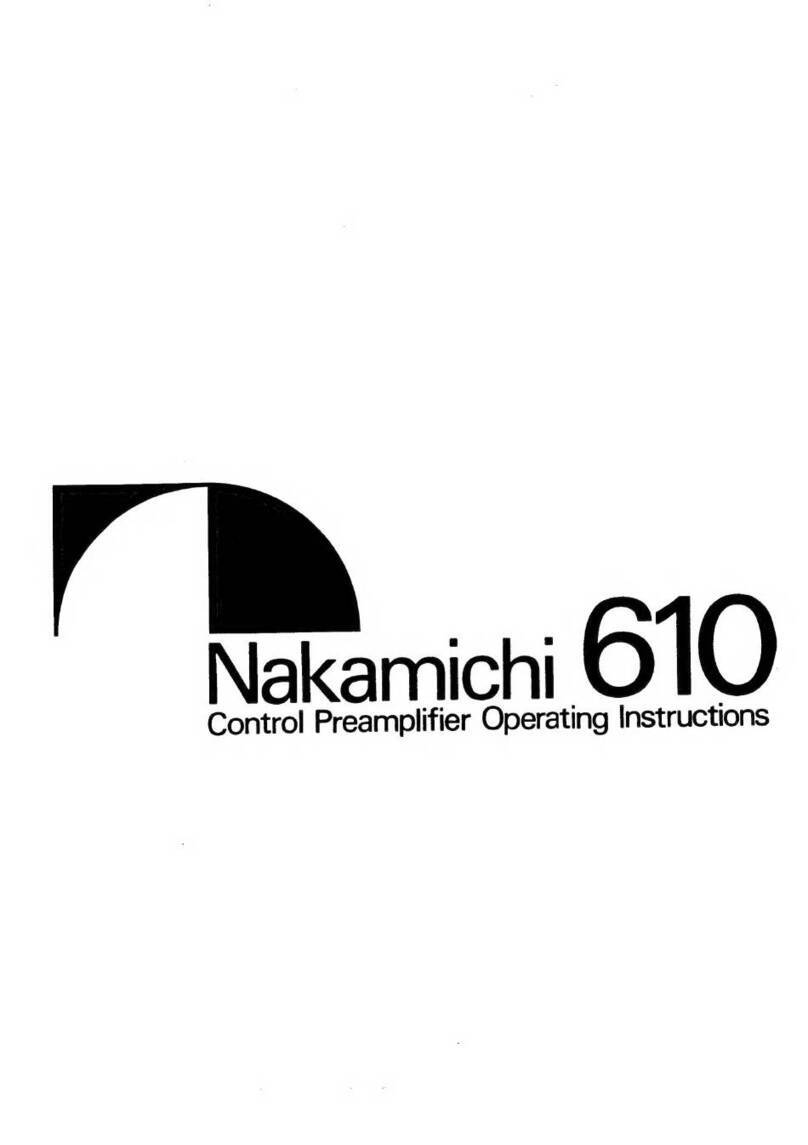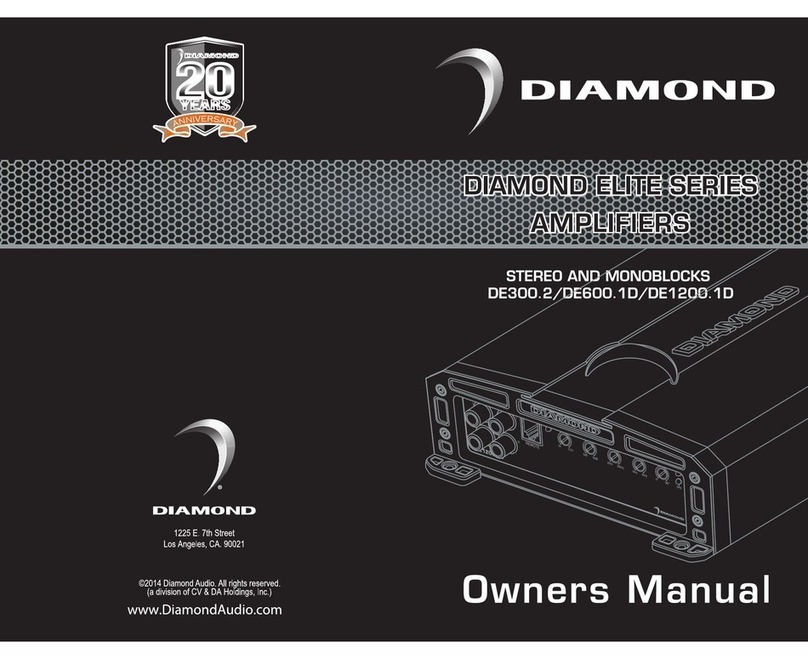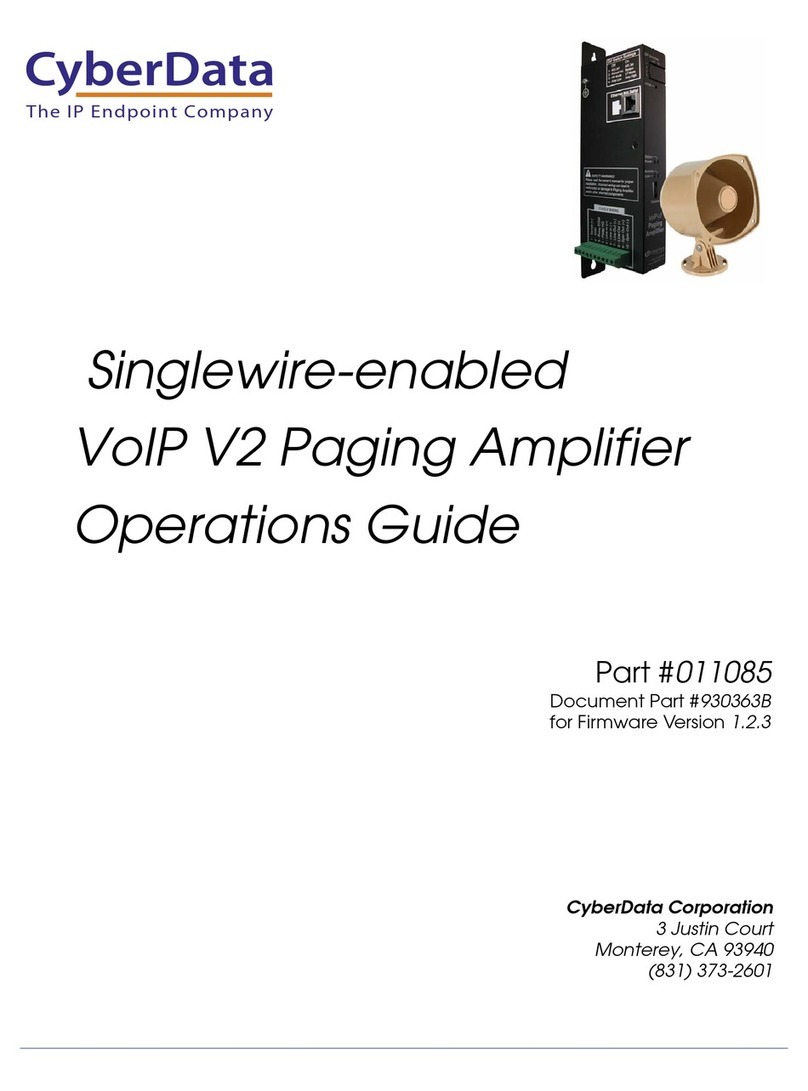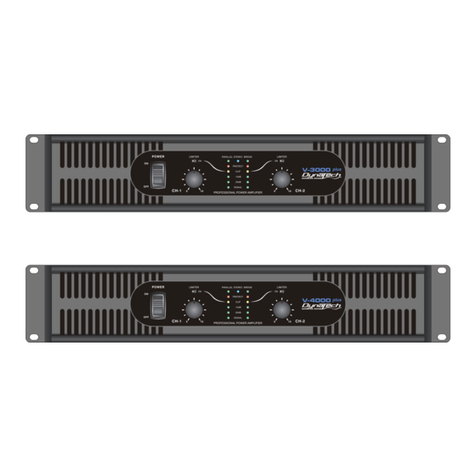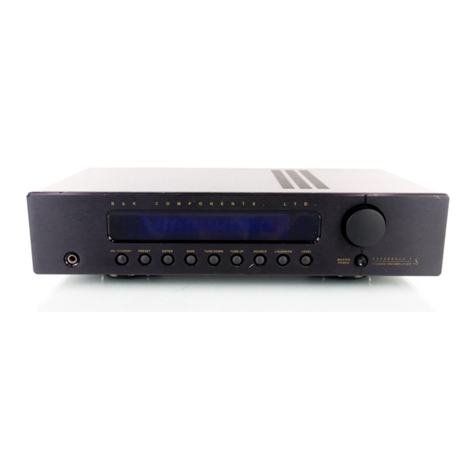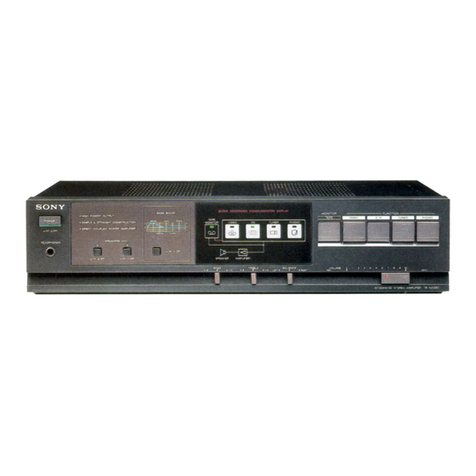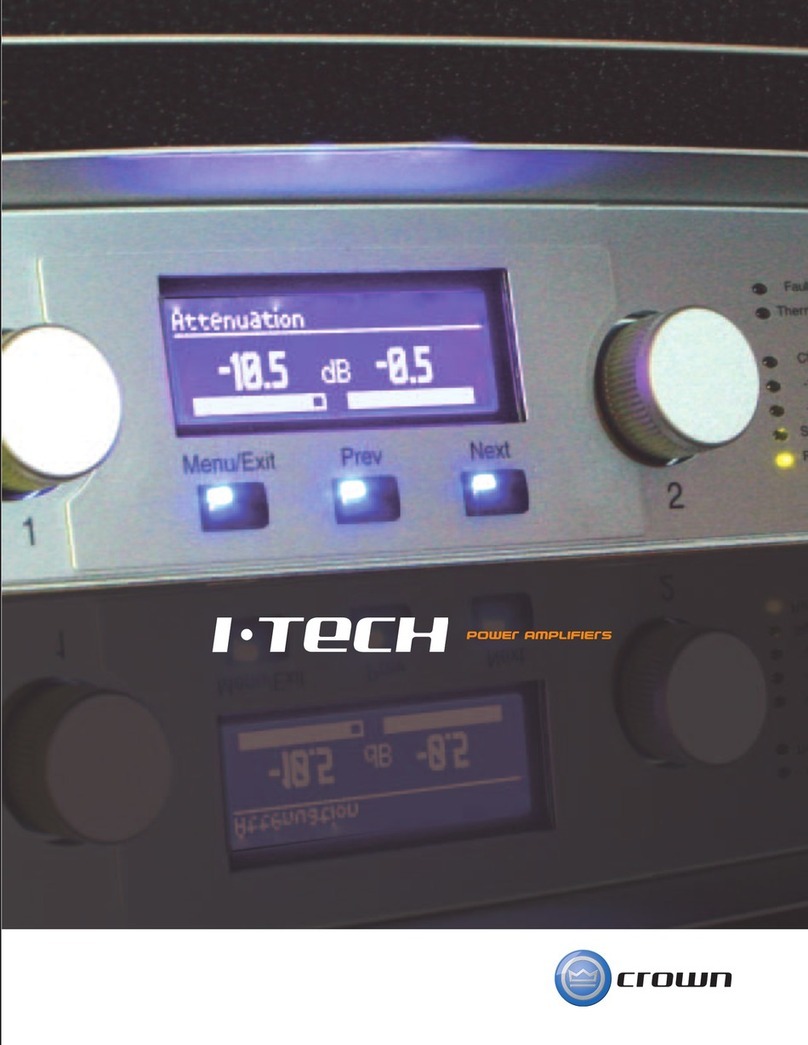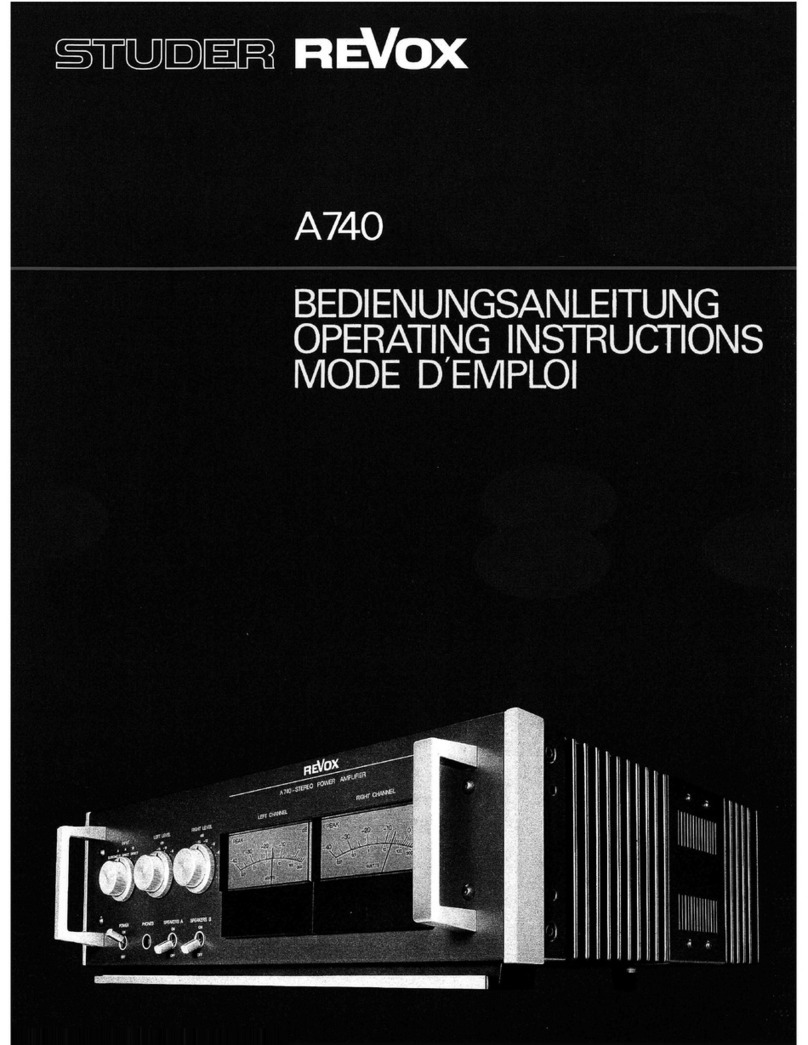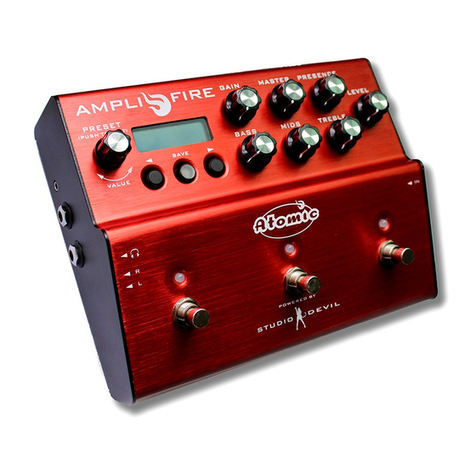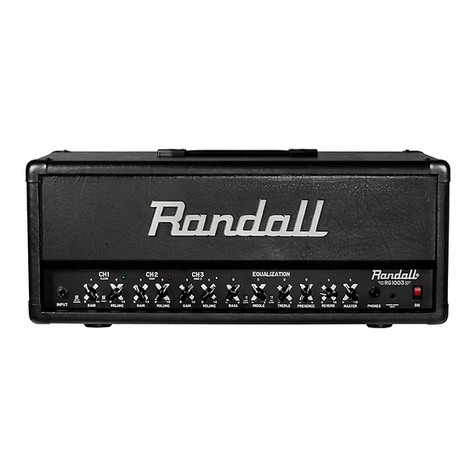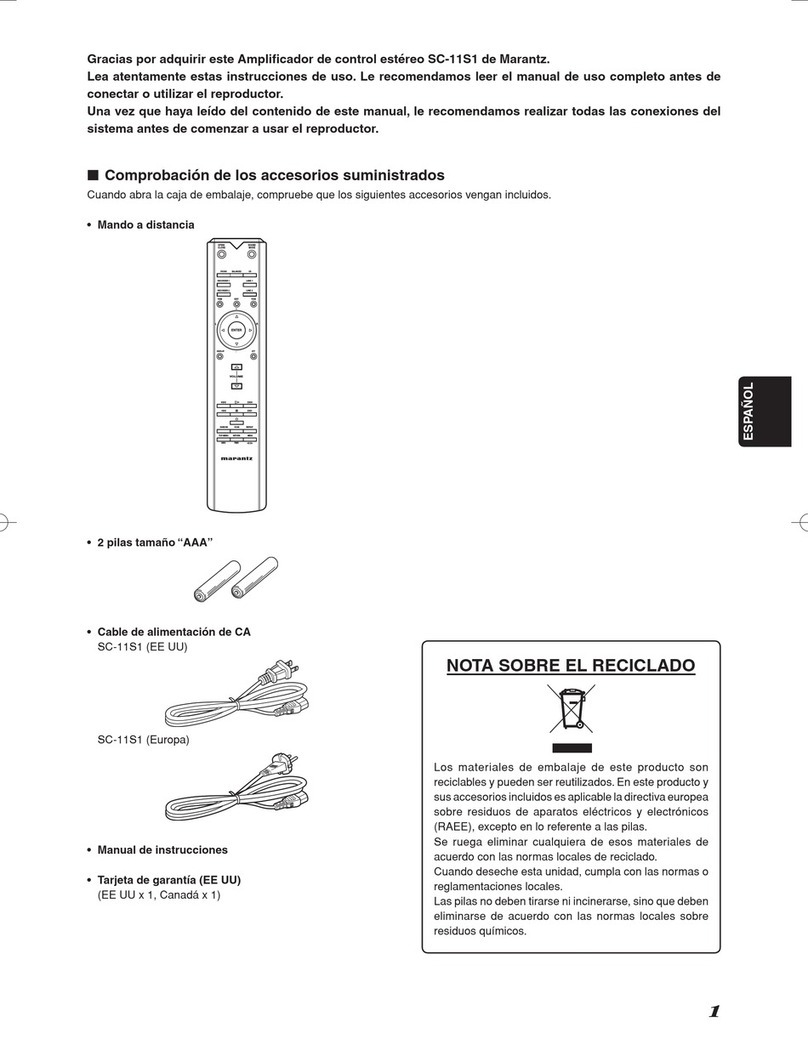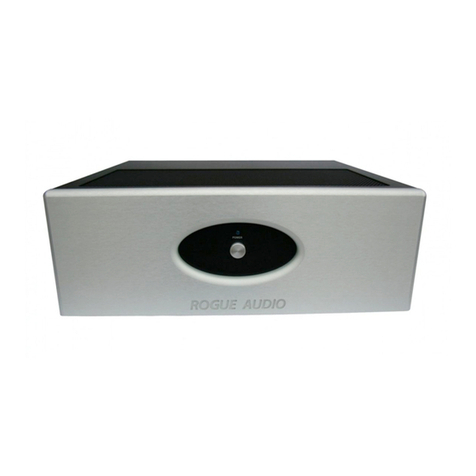Metaxas Audio Systems Ikarus User manual

KOSTAS METAXAS DESIGN
Ikarus
KOSTAS METAXAS DESIGN

KOSTAS METAXAS DESIGN
KOSTAS METAXAS DESIGN
Contents
Awards & Innovations 01
3 Decades of “Hi-End” 02
Listening Reference 05
Design Philosophy 06
Operating Instructions 11
What the critics say... 12
Specifications 14
Controls & Features 15
Maintenance 16
Schematic 18
EC Conformity 19

KOSTAS METAXAS DESIGN
Awards & Innovations
01
2 X AUSTRALIAN EXPORT AWARD, BHP STEEL DESIGN AWARD,
runner up in AUSTRALIAN SMALL BUSINESS AWARDS
First - Amplifiers- No wire construction with
shortest possible signal path
First - 'Capacitorless' circuits in Audio design
First power amplifier can put full power into
8 ohm load at 1.0MegaHertz!
(refer to article in USA "AUDIO").
First - High Speed diodes in power supply
First - DAC to use lowest jitter 'APOGEE CLOCK'
First - FULL range and high efficiency electrostatic
First - Audio Manufacturer to use BMW-Porsche CAD-PCB
software design systems
You are about to listen to
an amplifier which has
evolved from over 20 years
of dedicated listening and
the application of the
state-of-the-art in every
process of design and
manufacture. I’m sure
you’ll enjoy listening to it
as much as I do.
-Kostas Metaxas DESIGNER

KOSTAS METAXAS DESIGN
3 Decades of Hi-End : 1980’s
02
Opulence Preamplifier Assembly Engraving
Kostas Metaxas circa 1985 Soliloquy Monoblocks
Ecstatic & Revelation Electrostatics

KOSTAS METAXAS DESIGN
3 Decades of Hi-End : 1990’s
03
Apollo Speaker
Reference System circa 1992 Assembly Assembly CZAR 2-way full range electrostatic
Opulence, Marquis & Charisma Preamplifiers
Stainless Steel Turret Punching Iraklis “on-test”Empress Full-range electrostatics
using plastic-composite moulded
frame
PCB design EMPEROR Assembly

KOSTAS METAXAS DESIGN
04
Using technology borrowed from Aerospace and Formula 1, the new
Kostas Metaxas Audio designs reflect the extraordinary
advances that have been made recently in modelling and simulation
software.
For the first time, a High End Audio manufacturer offers audiophiles a
rare glimpse into the conception, design and execution of a complete
product on a component by component basis in 3D.
The Protel PCB software [www.protel.com] extends the quite normal
listening tests on a component by component level to the PCB level.
Schematic Based simulations can test [or verify] the PCB's signal integrity
by running the "Signal Integrity Simulator" which displays a Reflection and
Crosstalk Analysis. And the 3D visualization allows one to include the PCB
as part of the overall wholistic design.
Schematic Capture & PCB design Schematic “Spice” Circuit Simulation PCB Track Risetime & Slewrate signal
integrity testing. In-house RAPID PROTOTYPING Laser Engraving
3 Decades of Hi-End : 2000’s

KOSTAS METAXAS DESIGN
Listening Philosophy
05
The only way to design state-of-the-art audio equipment is to have
first-hand experience with the finest available recording equipment AND
playback equipment.
This is important for two reasons; it ensures that our designs work and
'mate-well' with other products and that their resolution is not limited
by the weakest link in the playback 'chain'.
Kostas Metaxas products have been conceived using
extensive listening tests with a variety of state-of-the-art ancillary
equipment for more than 25 years.
Our amplifiers have been designed using a variety of state-of-the-art
phono playback equipment and our ABSOLUTE REFERENCE -
a custom-made battery-powered Stellavox SM-8 Tape Recorder using
1/4" tape at 30 ips and a Stellavox TD-9 using 1/2" tape at 30 ips
specially calibrated for the Bruel & Kjaer 4003 1/4" omnidirectional
electrostatic instrumentation microphones.
REFERENCE

ULTRA-SHORT SIGNAL PATH :
NO-WIRE DESIGN
A prominent audio designer once described an amplifier as "A straight piece
of wire with gain". We take this further by featuring the shortest possible
signal path in a commercial amplifier. We do not use wire in any of our signal
paths and every component is directly soldered to one large printed circuit
board.
From input to output, the signal passes through no more than 150mm of P.C.
track. The transformer is connected with only 40mm of wiring to the PC
board. This is only possible with our unique construction which features the
complete amplifier (including filtering capacitors) is
assembled onto one single rectangular Printed Circuit Board where the four
sides connect directly to the inputs and outputs, power transistors on their
heat sinks and power transformer.
The audio signal passes through ONLY ONE TYPE OF WIRE which is the high
speed, wave controlled oxygen free copper of our PC board.
HIGH SPEED POWER SUPPLIES
Every power amplifier uses a large, high-current power transformer which
feeds a 'high-current' bridge rectifier to convert the AC from the transformer
into DC voltages which are then mains ripple filtered using massive, comput-
er grade capacitors.
The rectifier bridge that is normally used is relatively large, handles high
current and low voltage which slow switching speed because of its inherent
high internal capacitance.
It has a response time measured in milliseconds which if converted to fre-
quency would mean that it would have a frequency response from DC to
around 100Hz .
KOSTAS METAXAS DESIGN
Design Philosophy
06
Frequencies above 1 kHz would be unable to draw
current instantaneously from the power transformer and would need to
rely on the charge stored in the power supply filtering capacitors.
We replace this slow DC rectifier with ultra high speed diodes wired in
parallel with switching times in 'nanoseconds' which when converted to
audio frequencies have a frequency response from DC-10 MegaHertz.
High and low frequency currents can be drawn from the power supply
more effortlessly .
Design Philosophy

KOSTAS METAXAS DESIGN
Design Philosophy
07
LOW NOISE, HIGH SPEED VOLTAGE
REGULATOR DESIGN
The most significant difference between VALVE and TRANSISTOR circuits
is the amplifier/power supply interaction.
In VALVE amplifier, the high voltages (from 200-400 Volts DC) result in a
50,000 to 100,000 Ohms value for resistor R. The equivalent transistor
amplifier using much lower voltages (from 12-30 Volts) would have a
substantially lower value of R between 200 Ohms-100 Ohms. Therefore a
normal power supply in a transistor amplifier is more likely to affect the
transistor amplifier circuit compared to a Valve amplifier circuit.
If we assume that the regulator impedance at V+ is around 2 Ohms just for
the purpose of this illustration, then let us study the amplitude of the 10
VOLT sine wave as it goes through R and returns back to the OUTPUT of
the TRANSISTOR circuit and VALVE circuit.
In the VALVE circuit, when 10 VOLTS travels across the 50,000 Ohms R towards
the power supply impedance of 2 Ohms , the 10V signal is attenuated
50,000/2 = 25,000 times. Therefore 10V/25,000 = 0.0004 Volts of 1,0kHz sine
wave.
On its way back to the OUTPUT of the circuit it is attenuated by the
impedance of the amplifier (say 100 Ohms): 0.0004 Volts/50,000/1,000 =
0.000008 Volts. Therefore, 0.000008 VOLTS of out of phase sine wave
accompanies the 10 Volts sine wave as out-of-phase distortion in the VALVE
CIRCUIT.
In a normal TRANSISTOR circuit, the 10 VOLTS going across the 200 Ohms
resistor R would be attenuated only 10/200/2 = 0.1 VOLTS. On the way back
to the output, the voltage is attenuated by: 0.1V/200/1000 = 0.05 VOLTS of
out-of-phase sine wave added to the 10 VOLT output sine wave.
V1
12AX7
R1
47K R2
1.82k
RL
300k
C2
0.1uF
V+
Vin
VSIN
IN
OUT
V1
1kHz R1
47K
RL
7.75k
R2
1.8K
Q1
2N2222A
VCC
IN
C2
0.1uF
OUT

KOSTAS METAXAS DESIGN
Design Philosophy
08
In a normal Transistor circuit, the 'phase distortion' is 0.5% as compared to
0.000008% for a normal VALVE circuit .
If we monitor the V+ point of the transistor circuit using an oscilloscope, we
would notice this 0.1 Volts, 1.0 kHz signal. If we were to increase the
frequency to 10,000 Hz and up to 1.0 MegaHertz the speed of dynamic
behaviour of the power supply becomes critical. Using a normal I.C. regulator
would result in the signal at V+ actually increasing in amplitude as the
frequency increases to that at 1.0 MegaHertz the 1.0 Volt sine wave is now
over 1.0 Volt!
To fully understand this interaction between the amplifier an power supply,
it is necessary to understand how a voltage regulated power supply works.
A voltage regulated power supply is essentially a D.C. amplifier (not unlike a
normal power amplifier) which instead of having an audio signal at the input
which is then amplified to become a larger audio signal at the output, has a
fixed D.C. voltage reference at the input which is then amplified and
becomes a larger DC voltage of at the output. The output impedance of the
regulator, not unlike the output impedance (or "Damping Factor') of a power
amplifier is less than one ohm at D.C.
If we use a 2.0 Volt zener diode as our fixed DC voltage reference at the
input of the D.C. amplifier which has a gain of 10, the resulting output
voltage is 20 Volts D.C.
The negative feedback loop of the amplifier which fixes the gain of 10 times
the 2.0 Volt zener reference is very important because it maintains the
output voltage irrespective; of an increase or decrease in the power supply
voltage to the amplifier as long as there is a minimum voltage for the
regulator circuit to operate (for a 12 Volt regulator, the minimum voltage
is 15 Volts).
Figure 6. Output Impedance as a Function of
Output Voltage (MC78XXC, AC, B)
, OUTPUT IMPEDANCE (mą)
OΩ
10
5.0
3.0
2.0
1.0
0.5
0.3
0.2
0.1 .0 8.0 12 16 20 2
VO, OUTPUT VOLTAGE (V)
Z
f = 120 Hz
IO = 500 mA
CL = 0 µF
Figure 4. Ripple Rejection as a Function of
Frequency (MC78XXC, AC, B)
80
50
RR, RIPPLE REJECTION (dB)
0.1 10
f, FREQUENCY (kHz)
0.01
70
0
30
60
1.0
MC78XXB, C, AC
Vin = 8.0 V to 18 V
IO = 500 mA
f = 120 Hz
TA = 25°C
Figure 3. Ripple Rejection as a Function of
Output Voltages (MC78XXC, AC, B)
80
70
60
50
0
.0 6.0 8.0 10 12 1 16 18 20 22 2
VO, OUTPUT VOLTAGE (V)
RR, RIPPLE REJECTION (dB)
PART #ą ă Vin
MC7805Că= 10 V
MC7806Că= 11 V
MC7808Că= 1 V
MC7812Că= 19 V
MC7815Că= 23 V
MC7818Că= 27 V
MC782 Că= 33 V
f = 120 Hz
IO = 20 mA
∆Vin = 1.0 V(RMS)
DS009063-46

KOSTAS METAXAS DESIGN
Design Philosophy
09
This is the STATIC performance of a voltage regulator which although
important, does not affect the overall sound of the amplifier as much
as the regulator's DYNAMIC performance which is influenced by the
speed and 'open loop gain' of the regulator.
To understand why the Dynamic performance of a voltage regulator is so
important, we need to go back to our basic amplifier circuit and investi-
gate what happens to the 1.0 Hz, 10 Volt output signal as it goes across
resistor R and encounters our voltage regulator.
To ensure an absolutely stable D.C. at V+ the residual of the 10 Volt
sine wave at the OUTPUT is fed through the negative feedback loop of
the regulator to force the amplifier to correct this error by applying an
inverted signal identical to the residual sine wave to totally eliminate
the residual sine wave at V+. A high speed regulator would therefore
treat a signal 1.0 Mega Hertz in the same manner as a signal at 1.0kHz.
The ultimate voltage regulator would effectively have a theoretical
output impedance (or 'Damping Factor') at V+ of zero ohms at all fre-
quencies as a result of its wide bandwidth before the addition of nega-
tive feedback.
In this way, the attenuation of the 10 Volts across the resistor R resid-
ual would be complete, and no attenuated component of the 10 VOLT
sine wave could be deflected and return to the OUTPUT of the circuit
and cause severe phase anomalies by adding to the new signal p;resent-
ed at the output - remember that it would take a few nanoseconds for
the signal to go through the resistor and come back.
This extraneous out-of-phase information if allowed to adds to the new
OUTPUT signal, would then destroys TIME/PHASE characteristics of the
amplifier circuit.
In real world power supply circuits, the impedance of the power supply
actually increases with frequency because the open loop gain rolls off
at high frequencies .
45
R42
R38
R36
1
2
3
C9
R41
1
2
3Q34
C10
56
4
R128R127R126
Q18 Q22
Q19
Q25
Q27 Q26
Q24
Q31 Q32
Q28
Q23
Q17
Q29
1
2
3
1
2
3
Q30
2
1 3
Q200A
7
8 6
Q200B
R102R103
R101R108
R116
R115
R125
R124
R123
R117
R119
R118
R122
R105
R100
R109
R107
R106
R121R120
R104
R112
R111
R113
R110
R114
CE9
CE10
DZ1
L
Marquis Voltage Regulator

KOSTAS METAXAS DESIGN
Design Philosophy
10
If we go back to our basic circuit and analysed the performance of an I.C.
positive voltage regulator (say a LM78LXX from NATIONAL SEMICONDUCTORS)
it would have an output impedance at the pin of its output lead of around
0.2 Ohms from DC to 10kHz, and then an increase to 0.4 Ohms at 20kHz, then
4.0 Ohms at 1 MEGAHERTZ which clearly illustrates the open loop frequency
response has a turnover point around 10 kHz. When you add the normal dis-
tance between the regulator output and amplifier circuits which may be as
little as 60mm to as much as 200mm in many circuits, the overall impedance
in creases 5 to 10 times. Also, to stabilise the operation of this I.C.
regulator, it is essential to use an output capacitor for stability.
Clearly, this is not good enough for high performance, high speed transistor
circuits. For this reason, we have approached the design of our regulators as
PART of our amplifier circuits, rather than make the fastest amplifier circuit
and add a slow I.C. voltage regulator with an output capacitor and call it a
finished design. Our discrete voltage regulators are designed to have the
absolute lowest noise, reject mains ripple, but more importantly to have a
speed (1000 V/microsecond) which is a result of their wide bandwidth design
(an open loop frequency response greater than 500kHz) and output imped-
ance which is an order of magnitude better than any I.C. The regulator
stability is achieved without ANY capacitors by varying the ratio between
the local and overall feedback of each device.
We position the regulators within inches of the active circuits (in the case
of the OPULENCE, the regulator is 3mm! from the active circuits) and the
regulator impedance is flat from DC to beyond 5 MegaHertz at less than
0.05 Ohms.
Beyond this electrical design aspect, we listen to the sound of our
regulators whilst developing each amplifier circuit to ensure that every
component change or substitution produces an audible improvement from
the selection of transistors to best biasing currents , choice of voltage
references zeners and degree of local feedback.
Marquis “wholistic” approach to Line Stage/Regulator

KOSTAS METAXAS DESIGN
Operating Instructions
11
Steps for Connection
1. Ensure that the ON/OFF switch on the back panel is in the OFF position before
connecting the amplifier into your system.
2. Once connected, ensure that there are no 'short circuits' in the speaker wires, then
proceed to switch the unit ON.
Note: For the best results, it is recommended that the unit is powered on for at least 15
minutes before critical listening is attempted.
OPTIONAL PHONO STAGE - This needs to be installed BEFORE you take delivery of your
amplifier. Please refer to the additional Instructions that come with the PHONO STAGE.
Protection Circuits
The output stage of the amplifier is fused with +/- 2A fast blow fuses [M205 type] which
protects the amplifier in case of operating faults. The low value of fuse inherently
protects the following loudspeakers without the need for adding an OUTPUT RELAY.
Mains Fuse
A 2AMP SLOW BLOW DA205 Type fuse is located on the AC MAINS SOCKET. If this blows,
simply replace with the same rating fuse. If the fuse continues to blow, please refer to the
Maintenance Section of this manual for further instructions.
Serviceability
The complete active circuitry of the Iraklis including primary filtering capacitors are all
mounted to the large single ground P.C.B. Easy access to the board is maintained by simply
removing the base to gain access to the 'component side' to change a blown fuse.

KOSTAS METAXAS DESIGN
What the critics say...
12
"It has taken little time for Australian firm MAS to receive worldwide attention .In
France,the range of MAS Electronics has seduced us... Metaxas products belong to
this rare category of electronics which achieve the essential and vital qualities of a
good Hi Fi system which drive you to irresistibly listen and enjoy records one after
the other".
Jean Hiraga/Patrick Vercher LA NOUVELLE REVUE DU SON, France.
"The IKARUS manages to combine two characteristics which are generally incompati-
ble; on the one hand it succeeds in X-raying the music, whilst at the same time, it
preserves its spirit and its musicality.The Ikarus is in fact an excellent product, rich
in personality, refined, easy to use, very pretty, but most of all, it is a high class
product.
Silvio Delfino FEDELTA DEL SUONO, Italy
" Provided that the back-up components are of good quality, listeners can expect
lush, well produced sounds closely akin to vacuum tubes. The unit's presentation of a
soundstage is astounding. All dimensions are faithfully reproduced with the appropri-
ate focal impact. There is enough air around instruments and voices to beguile even
seasoned listeners".
Ernie Fisher, THE INNER EAR REPORT, Canada.
"In my listening sessions, the IKARUS amazed me with what 40Watts can sound like.
Mids were neutral and transparent and the highs were shimmering and detailed with
neither harshness nor a hard gloss. The sound is astonishingly finely etched, even at
very low volume levels. For sheer beauty (sonic and visual), uncharacteristically good
connection flexibility and the ability to drive difficult audiophile speakers, the MAS
IKARUS is the best 40Watter around".
Greg Borrowman, AUSTRALIAN HI FI, Australia.

KOSTAS METAXAS DESIGN
What the critics say...
13
"However I come to peace with myself by the sound of the IKARUS. The Australian
neither oversearches for superfine details, nor omits any information. The IKARUS
plainly serves the music. Searching carefully for its characteristic features, one
notices that it produces an exceptionally broad soundstage in the listening room."
Ulrick Michalik, HI FI EXCLUSIV, Germany.
"I'm surprised that this slim and simple appearance IKARUS integrated amplifier can
perform almost perfect sound quality and high drive power. Output stage is normal
class AB with 40WRMS into 8 Ohms, but with such a natural and clear performance, it
sounds like class A. Even with its slim body, it drives speakers to loud levels with a
vividness with fine energy levels from all frequencies".
Mitsugu Kobayashi STEREO SOUND Japan
"On modern music (jazz , fusion and even rock), the IKARUS is very impressive. Its
sound is correctly aggressive but at the same time warm and liquid; it captivates
with the intense fascination of the sound it portrays. But it is with the late-night lis-
tening session at home with the volume control set just right so as not to disturb
anyone, family or neighbours, that the IKARUS reaches the pinnacle of enjoyment.
Joe Henderson breathes into the mouthpiece of his tenor sax 'Miles Ahead', the win-
dow is open to let a breath of fresh air in to take the place of the torrid daytime
heat. Ah...tender is the night..."
PierLuigi Sandonnini & Fabrizio Montanucci SUONO Italy.
"In contrast, the Metaxas presented more information especially 'in space'. Thanks to
additional details and finer presentation, the IKARUS succeeded to demonstrate more
clearly the characteristics of different recording techniques on a demo CD."
RATING: Absolute Spitzenclasse IV REFERENCE (This is the highest rating for integrat-
ed amplifiers in German STEREOPLAY)
Wilfried Kress, STEREOPLAY Germany.
For full reviews, visit http://www.metaxas.com

KOSTAS METAXAS DESIGN
Specifications
14
The IKARUS is based on our successful IRAKLIS power amplifier
schematic with an additional 10dB increase in overall gain. It acts as
both line stage and power amplifier stage with only 6dB of negative
feedback, eliminating an unnecessary amplifier circuit from the
signal path.
Sporting the same overall construction quality of hand-engraved pan-
els, machined stainless steel knobs, tiffany connectors, milspec
double-sided oxygen-free copper PC Board and highly polished
stainless steel case. Each IKARUS is individually numbered.
Using a complete dual mono approach in power supplies with
separate individual high-speed rectifier diodes and almost 40,000uF of
filtering supplies, only the large 200WATT toroid transformer is shared
by both channels.
A high quality rotary switch and potentiometer (ALPS in this case) are
the only components the signal encounters on its way to the high
quality amplifier circuits, allowing an incredible wealth of fine
musical nuance to pass directly through to the loudspeaker.
Specifications
FREQUENCY RESPONSE : DC - 5.0MHz (-3dB)
POWER OUTPUT : 45WRMS per channel into 8 Ohms with no
more than 0.05% T.H.D.
DAMPING FACTOR : Greater than 500 wide band
SLEW RATE : Greater than 1000V/us small and large signal
T.H.D. : Less than 0.05% 20Hz-20KHz
I.M.D.(S.M.P.T.E.) : Less than 0.05%
SIGNAL/NOISE : -117DBV unweighed input shorted
SENSITIVITY : 0.5VRMS in for 45WRMS out (35dB)
INPUT IMPEDANCE : 100kOhms in parallel with 11pF

KOSTAS METAXAS DESIGN
Controls & Features
15

KOSTAS METAXAS DESIGN
Maintenance
16
TESTING
1. Connect the + and - supply lines [at the FUSEHOLDERS or RECTIFIER DIODES] to an
external current limiting Power Supply with maximum +/- 30VDC output voltage (or use
2 x 30VDC supplies).
2. Rotate the biasing trimpots VR5 & VR5a fully clockwise.
3. Connect the amplifier to a signal source (Sound Technology 1700B or Oscillator) which
generates sine waves at 1.0kHz frequency and monitor the input and output on a dual
trace Oscilloscope.
4. Power the module on (ensure that only 1.0 A fuses are installed for extra safety) and
check that there is no current limiting. You should be able to monitor the amp on the
Oscilloscope. (Connect your
oscillator to any HIGH LEVEL input, and ensure that MUTING switch is in the UP position,
and VOLUME control is at position 9).
5. Measure the voltage drop after the "capacity
multipliers" [across the collector & emitter of Q19, 17, 19a 17a for the input stage and
Q23,25,23a,25a for the output stage ]which should be ~2 volts . If either the positive or
negative series-pass transistors drop more than this voltage, check their VBE (voltage
between the base and the emitter) and ensure that it is not more than 0.65V. If a
greater value is measured, replace the faulty transistor.
6. If voltages are O.K. check the waveform on the oscilloscope, it should show crossover
distortion.,
7. Clip a multimeter across any of the [20X] 10 OHMS output stage emitter resistors and
turn the trimpot clockwise until you measure approx. 0.02 VDC across this resistor.
Maintain for 30 minutes, adjusting the pot as the amp warms up.
IF A FUSE BLOWS
1. Check the 30 OHMS resistors in series with the BASE of the output transistors
[R49,39,40,59] to ensure that they have not "open circuited" - i.e. that they are
not burnt.
2. Measure the DC resistance between any of the three leads of a power transis-
tors Q14,15,22,24 or driver transistors Q12,13 [the transistors mounted on the
heat sink bracket]. If you measure less than 100 Ohms between any two leads,
then the device is faulty and must be replaced.
3. Connect the BLACK multi meter lead to earth and check for any short circuits
on the positive or
negative voltage rails.
4. If the MAIN FUSE blows then check the SF16
rectifier diodes DE5,6,7,8,9,10,11,12, for a short circuit. if they measure less than
100 Ohms, replace them.
5. DC Offset Voltage at Output. Connect multimeter probes to the BLACK and RED
speaker terminals to measure the DC offset. It should be less than 0.05VDC. If it is
greater than this please check the LF351 DC SERVO IC[U1]. Check that they are
receiving voltage at Pin 4 (-15V) and Pin 7 (+15V) and replace if necessary.
6. Biasing Trimpot has not effect.
Replace the 2N4401 transistor next to the TRIMPOT.

KOSTAS METAXAS DESIGN
Maintenance
17

KOSTAS METAXAS DESIGN
Schematic
1 2 3 4
A
B
C
D
4
321
D
C
B
ATitle
Number RevisionSize
A4
Date: 6-Jul-2003 Sheet of
File: C:\MAS PROTEL\_ikarus_FINAL\ikarus_Final.ddbDrawn By:
Kostas Metaxas
Q10
R21 R22
R24 R25
R13
R19
R28
R29
R12R11
R18R17
R34
R45 R49
R39
R48
R40
R10R9
R16R15
R46 R47 R50 R53
R26
R27
R14
R20
R23
R4
R73
R8
R2
R3
R1
R6
R5
R7
VR5
D1
D2
R30
R31
3
26
1
5
74
U1
Q2
Q4
Q3
R42
C3
C6
C7
C8
C4
C5
C1
C2
R38
R36
R43
Q19
Q18 C9
R41
R44 Q17
Q16
C10
R52R51 R54
R35
R32
R33
R55 R59R58R56 R57 R60 R64R62R61 R63
Q10a
R21a R22a
R24a R25a
R13a
R19a
R28a
R29a
R12aR11a
R18aR17a
R34a
R45a R49a
R39a
R48a
R40a
R10aR9a
R16aR15a
R46a R47a R50a R53a
R26a
R27a
R14a
R20a
R23a
R4a
R73a
R8a
R2a
R3a
R1a
R6a
R5a
R7a
VR5a
D1a
D2a
R30a
R31a
3
26
1
5
74
U1a
Q2a
Q1a
Q4a
Q3a
R42a
C3a
C6a
C7a
C8a
C4a
C5a
C1a
C2a
R38a
R36a
R43a
Q19a
Q18a C9a
R41a
R44a Q17a
Q16a
C10a
R52aR51a R54a
R35a
R32a
R33a
R55a R59aR58aR56a R57a R60a R63aR62aR61a R64a
METAXAS AUDIO SYSTEMS IKARUS INTEGRATED AMPLIFIER
F2 F3 F4 F5
CE1 CE2 CE3 CE4 CE5 CE6 CE7 CE8
DE5 DE6 DE7 DE8 DE9 DE10 DE11 DE12
R75a
R75
R74a
R74 C13
C13a
L1 L1a
LS1 LS2
CP1 CP2
CP3 CP4
R66
R67
R65
R37
DL2 DL1
DL4
DL3
VOL_RVOL_L
+30V
-30V
1
23
Q12 1
23
Q12a
1
2 3
Q13a
1
2 3
Q13 1
2 3
Q14 1
2 3
Q14a
1
23
Q15a
1
23
Q15
1
2
3
Q9a
1
2
3
Q9
1
2
3
Q11
1
2
3
Q11a
Q5 Q6 Q5a Q6a
Q7a
Q8a
Q7
Q8
Q1
4 6
5
3 1
2RA1
1
2
3
4
JP1
meterL meterR
18
Table of contents
